Potřebujeme váš souhlas k využití jednotlivých dat, aby se vám mimo jiné mohly ukazovat informace týkající se vašich zájmů. Souhlas udělíte kliknutím na tlačítko „OK“.
ASTM D4623-08
Standard Test Method for Determination of In Situ Stress in Rock Mass by Overcoring Method´USBM Borehole Deformation Gauge
Automaticky přeložený název:
Standardní zkušební metoda pro stanovení in situ napětí v horninovém masivu pomocí vrtného Method'USBM vrty deformační tlakoměr
NORMA vydána dne 1.7.2008
Informace o normě:
Označení normy: ASTM D4623-08
Poznámka: NEPLATNÁ
Datum vydání normy: 1.7.2008
Kód zboží: NS-27929
Počet stran: 14
Přibližná hmotnost: 42 g (0.09 liber)
Země: Americká technická norma
Kategorie: Technické normy ASTM
Kategorie - podobné normy:
Zemní práce. Hloubicí práce. Budování základů. Podzemní práce
Anotace textu normy ASTM D4623-08 :
Keywords:
borehole, core, deformation, drilling, gauge, in situ, measurements, moduli, overcoring, rock, stress, Borehole drilling, Deformation--rock, Equipment malfunction, Field testing--rock, Fracture testing--rock, Gages, Overcore, Poisson&apos,s ratio, Pressure testing--rock, Rock drilling/coring/investigation, Stress--rock, Young&apos,s modulus, ICS Number Code 93.020 (Earth works. Excavations. Foundation construction. Underground works)
Doplňující informace
| Significance and Use | ||||||||||||
|
Either virgin stresses or the stresses as influenced by an excavation may be determined. This test method is written assuming testing will be done from an underground opening; however, the same principles may be applied to testing in a rock outcrop at the surface. This test method is generally performed at depths within 50 ft (15 m) of the working face because of drilling difficulties at greater depths. Some deeper testing has been done, but should be considered developmental. It is also useful for obtaining stress characteristics of existing concrete and rock structures for safety and modification investigations. This test method is difficult in rock with fracture spacings of less than 5 in. (130 mm). A large number of tests may be required in order to obtain data. The rock tested is assumed to be homogeneous and linearly elastic. The moduli of deformation and Poisson's ratio of the rock are required for data reduction. The preferred method for determining modulus of deformation values involves biaxially testing the recovered overcores, as described in Section 8. If this is not possible, values may be determined from uniaxial testing of smaller cores in accordance with Test Method D 7012. However, this generally decreases the accuracy of the stress determination in all but the most homogeneous rock. Results may be used from other in situ tests, such as Test Method D 4394 and Test Method D 4395. The physical conditions present in three separate drill holes are assumed to prevail at one point in space to allow the three-dimensional stress field to be estimated. This assumption is difficult to verify, as rock material properties and the local stress field can vary significantly over short distances. Confidence in this assumption increases with careful selection of the test site. Local geologic features with mechanical properties different from those of the surrounding rock can influence significantly the local stress field. In general, these features, if known to be present, should be avoided when selecting a test site location. It is often important, however, to measure the stress level on each side of a large fault. All boreholes at a single test station should be in the same formation. Since most overcoring is performed to measure undisturbed stress levels, the boreholes should be drilled from a portion of the test opening at least three excavation diameters from any free surface. The smallest opening that will accommodate the drilling equipment is recommended; openings from 8 to 12 ft (2.4 to 3.6 m) in diameter have been found satisfactory. A minimum of three nonparallel boreholes is required to determine the complete stress tensor. The optimum angle each hole makes with the other two (trihedral arrangement) is 90°. However, angles of 45° provide satisfactory results for determining all three principal stresses. Boreholes inclined upward are generally easier to work in than holes inclined downward, particularly in fractured rock. Note 2—The quality of the result produced by this standard is dependent on the competence of the personnel performing it, and the suitability of the equipment and facilities used. Agencies that meet the criteria of Practice D 3740 are generally considered capable of competent and objective testing/sampling/inspection/ and the like. Users of this standard are cautioned that compliance with Practice D 3740 does not in itself assure reliable results. Reliable results depend on many factors; Practice D 3740 provides a means of evaluating some of those factors. |
||||||||||||
| 1. Scope | ||||||||||||
|
1.1 This test method covers the determination of the ambient local stresses in a rock mass and the equipment required to perform in situ stress tests using a three-component borehole deformation gauge (BDG). The test procedure and method of data reduction are described, including the theoretical basis and assumptions involved in the calculations. A section is included on troubleshooting equipment malfunctions. Note 1—The gauge used in this test method is commonly referred to as a USBM gauge (U.S. Bureau of Mines three-component borehole deformation gauge). 1.2 The values stated in inch-pound units are to be regarded as standard. No other units of measurement are included in this standard. 1.3 This standard does not purport to address all of the safety problems, if any, associated with its use. It is the responsibility of the user of this standard to establish appropriate safety and health practices and determine the applicability of regulatory limitations prior to use. |
||||||||||||
| 2. Referenced Documents | ||||||||||||
|
Podobné normy:
Historická
15.6.2009
Historická
1.10.2008
Historická
1.3.2013
Historická
1.7.2008
Historická
15.9.2007
Historická
15.3.2010


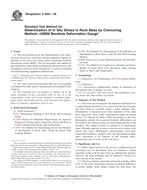
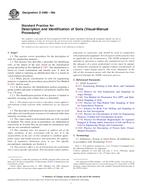 ASTM D2488-09a
ASTM D2488-09a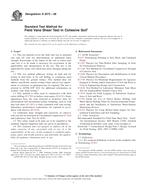 ASTM D2573-08
ASTM D2573-08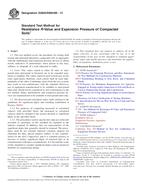 ASTM D2844/D2844M-13..
ASTM D2844/D2844M-13..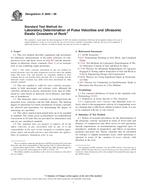 ASTM D2845-08
ASTM D2845-08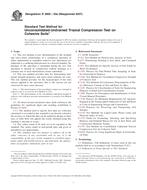 ASTM D2850-03a(2007)..
ASTM D2850-03a(2007)..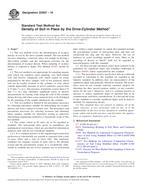 ASTM D2937-10
ASTM D2937-10
 Cookies
Cookies
